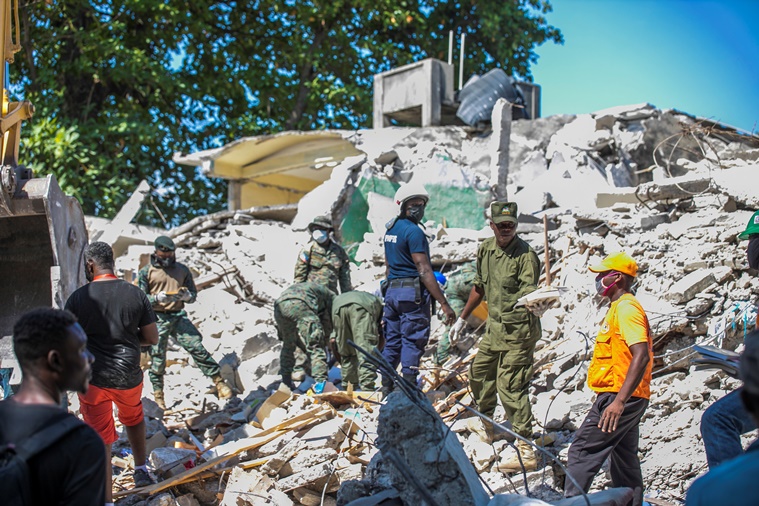Why Haiti is prone to devastating earthquakes?
Haiti seismic tremor: The Earth's covering is comprised of structural plates that move. What's more, Haiti sits close to the convergence of two of them - the North American plate and the Caribbean plate.
Quakes have been unleashing ruin in Haiti since essentially the eighteenth century, when the city of Port-au-Prince was obliterated twice in 19 years. The 21st century has been no less kind. Saturday's amazing shudder killed hundreds and harmed thousands more. Eleven years sooner a quake killed a huge number of individuals, if not many thousands.
Haiti sits close to the crossing point of two structural plates that make up the Earth's covering. Quakes can happen when those plates move against one another and make erosion. Haiti is additionally thickly populated. Also, a large number of its structures are intended to withstand tropical storms, not tremors. Those structures can endure solid breezes yet are helpless against breakdown when the ground shakes.
What makes Haiti inclined to tremors?
The Earth's hull is comprised of structural plates that move. Also, Haiti sits close to the convergence of two of them — the North American plate and the Caribbean plate.
Numerous separation points between those plates slice through or close to the island of Hispaniola, which Haiti imparts to the Dominican Republic. What's more regrettable, not those separation points act the same way.
"Hispaniola sits in where plates change from crushing together to sliding past each other," said Rich Briggs, an examination geologist at the US Geological Survey's Geologic Hazards Science Center (USGS).
"It resembles a stone stuck in the track of a sliding glass entryway," he said. "It simply doesn't have any desire to move flawlessly on the grounds that it has such countless various powers on it."
What caused the latest shake?
Saturday's size 7.2 seismic tremor probably happened along the Enriquillo-Plantain Garden flaw zone, what cuts across Haiti's southwestern Tiburon Peninsula, as per the USGS.
It's a similar deficiency zone along which the overwhelming 2010 seismic tremor happened. Also, it's reasonable the wellspring of three other large seismic tremors in Haiti somewhere in the range of 1751 and 1860, two of which annihilated Port-au-Prince.
Tremors are the aftereffect of the structural plates gradually moving against one another and making rubbing over the long haul, said Gavin Hayes, senior science consultant for quake and geologic risks at USGS.
"That rubbing develops a lot up and in the long run the strain that is put away there defeats the contact," Hayes said. "What's more, that is the point at which the flaw moves out of nowhere. That is the thing that a seismic tremor is."
For what reason can seismic tremors in Haiti be so destroying?
It's a blend of elements that incorporate a seismically dynamic region, a high populace thickness of 11 million individuals and structures that are regularly intended to withstand storms — not quakes.
Normal cement and soot block structures can endure solid breezes yet are helpless against harm or breakdown when the ground shakes. Helpless structure practices can likewise assume a part.
The 2010 shake hit nearer to thickly populated Port-au-Prince and caused far and wide annihilation. Haiti's administration put the loss of life at more than 300,000, while a report dispatched by the US government put it somewhere in the range of 46,000 and 85,000.
"I believe perceive that there's nothing of the sort as a cataclysmic event," said Wendy Bohon, a geologist with Incorporated Research Institutions for Seismology. "What you have is a characteristic danger that covers with a weak framework."

 Haiti death toll has reached 1297 due to the magnitude 7.2 quake.
Haiti death toll has reached 1297 due to the magnitude 7.2 quake.
![[UPDATED 2021 NEW ] area of circle program in c | What are 2πr and πr2 in Circle](https://blogger.googleusercontent.com/img/b/R29vZ2xl/AVvXsEgE4fwhcqgbFOw26vbh2aAKFYyrCxDsvJt8Lde07EZUNB3do3R83fxO0z1kV2Ha_TjjRu4YXGh352PUSuVTNscMs55jR-ULRtWQVTVGbEBUySF5ByqWoC_iasEoK5tniXsd0hfEzG1UIVs/s72-w640-c-h444/area-of-circle-program-in-c.PNG)

![[UPDATED 2021 NEW ] area of circle program in c | What are 2πr and πr2 in Circle](https://blogger.googleusercontent.com/img/b/R29vZ2xl/AVvXsEgE4fwhcqgbFOw26vbh2aAKFYyrCxDsvJt8Lde07EZUNB3do3R83fxO0z1kV2Ha_TjjRu4YXGh352PUSuVTNscMs55jR-ULRtWQVTVGbEBUySF5ByqWoC_iasEoK5tniXsd0hfEzG1UIVs/w72-h72-p-k-no-nu/area-of-circle-program-in-c.PNG)

No comments:
Post a Comment